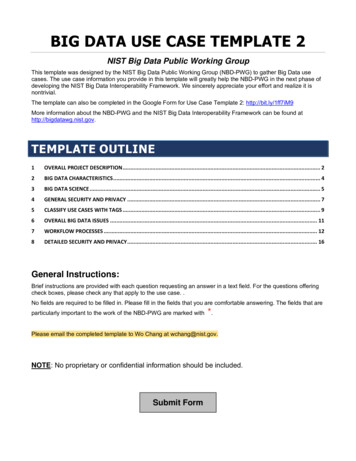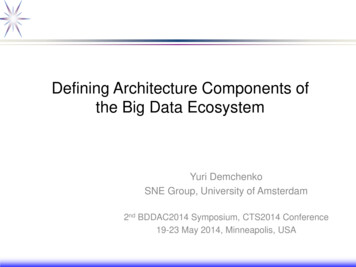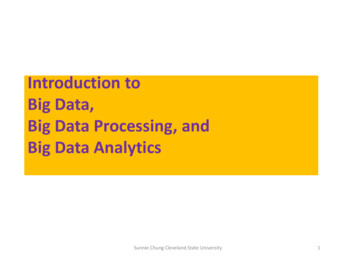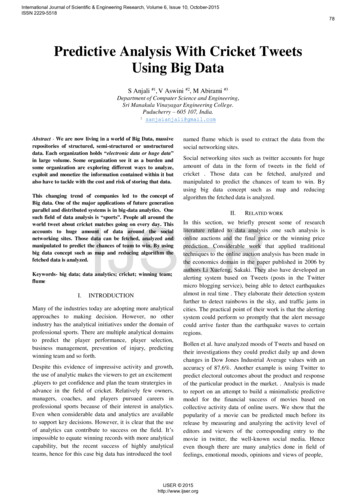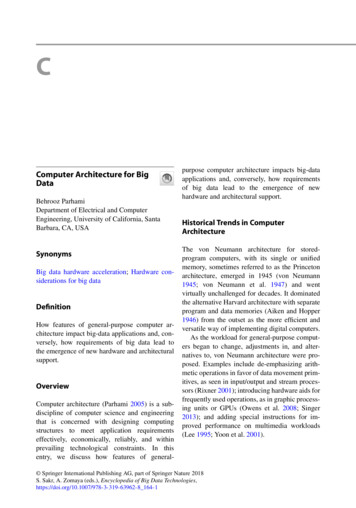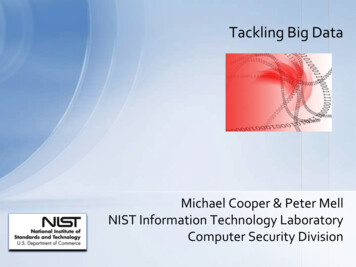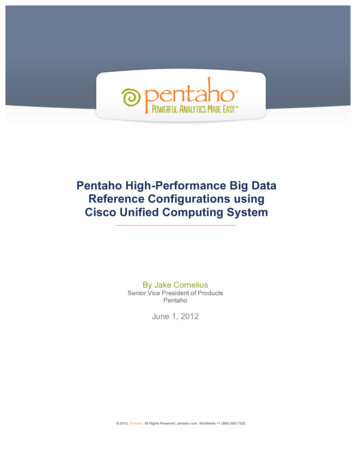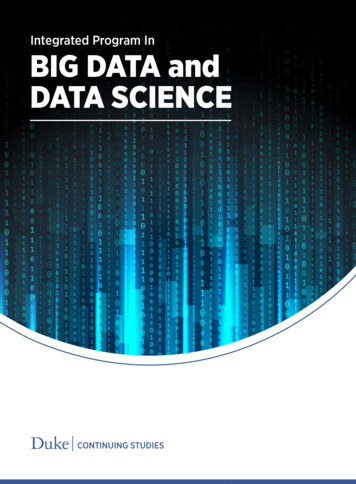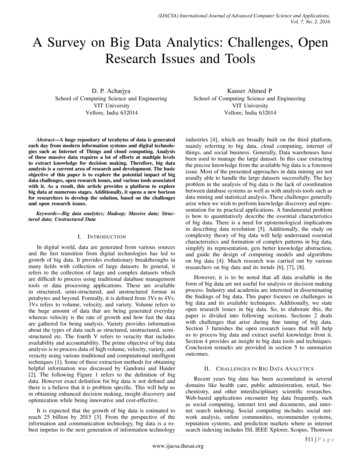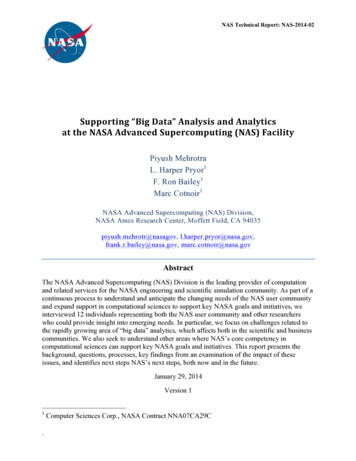
Transcription
NAS Technical Report: yush MehrotraL. Harper Pryor1F. Ron Bailey1Marc Cotnoir1NASA Advanced Supercomputing (NAS) Division,NASA Ames Research Center, Moffett Field, CA 94035piyush.mehrotr@nasagov, l.harper.pryor@nasa.gov,frank.r.bailey@nasa.gov, marc.cotnoir@nasa.govAbstractThe NASA Advanced Supercomputing (NAS) Division is the leading provider of computationand related services for the NASA engineering and scientific simulation community. As part of acontinuous process to understand and anticipate the changing needs of the NAS user communityand expand support in computational sciences to support key NASA goals and initiatives, weinterviewed 12 individuals representing both the NAS user community and other researcherswho could provide insight into emerging needs. In particular, we focus on challenges related tothe rapidly growing area of “big data” analytics, which affects both in the scientific and businesscommunities. We also seek to understand other areas where NAS’s core competency incomputational sciences can support key NASA goals and initiatives. This report presents thebackground, questions, processes, key findings from an examination of the impact of theseissues, and identifies next steps NAS’s next steps, both now and in the future.January 29, 2014Version 11 Computer Sciences Corp., NASA Contract NNA07CA29C
NAS Technical Report: NAS-2014-02Supporting Big Data Analysis and Analytics at NAS1. Statement of the Problem & BackgroundThe NASA Advanced Supercomputing (NAS) Division is well established as the leadingprovider of computational resources and related services for NASA’s engineering/scientificmodeling and simulation communities. To maintain this position, NAS constantly strives tounderstand and anticipate the needs of these communities in order to evolve NAS services tomeet their changing needs. Division leaders also seek to understand other areas where theNAS core competency in computational sciences can support key NASA goals andinitiatives.An important issue facing NASA, for both current NAS users and potential new users, is theexplosion of data that is variously referred to as “big data” and “data-intensive science.”NAS users are already involved in the latter. Their codes use and generate very largedatasets, and analysis of these datasets is an important part of the scientific/engineeringworkflow. NASA is also an important provider of big data, particularly satellite remotesensing data. The challenge of extracting knowledge and information from such largedatasets is driving the emergence of new approaches to “big data analytics” and “predictiveanalytics,” both in the scientific and business communities.This report presents the results of an examination of the impact of these issues on NAS.Specifically, we set out to address the following questions: What does NAS need to do to serve the analysis/analytics needs of our users—now andin the future?– Does Pleiades fill the need or does NAS need to do something else? How we can expand NAS’s role in analysis/analytics of NASA big data?– Can we provide similar services to the big data community as we provide to thesimulation community?To answer these questions, we need to: Understand what our users are doing and where they are going in analysis/analyticsUnderstand what others are doing and where they are going in analysis/analyticsDetermine the unmet needs2. DefinitionsBig data, analysis, and analytics are not precisely defined terms, but some definition isneeded to provide context.Big data is defined by more than just the amount of data. The key point about big data is thatthe size and characteristics of datasets being addressed overwhelm traditional, existing datamanagement and analysis techniques, and therefore require novel algorithms, infrastructure,and frameworks to perform advanced analytics. Big data is data processing at a scale that isnot just quantitatively big, but qualitatively different. This is similar to some informalVersion 1 – January 29, 20141
NAS Technical Report: NAS-2014-02Supporting Big Data Analysis and Analytics at NASdefinitions of supercomputing which state that if you can do it with mainstream technology,it isn’t supercomputing.A common way of characterizing big data is according to “three Vs” namely volume,velocity, and variety. The point being that, in addition to sheer size, the speed of data movingacross systems and networks and the variety of content add to the challenge of exploiting bigdata.Analysis and analytics are best thought of as a continuum, as shown below. At one end of thespectrum, analysis is characterized by more knowledge about the data and the processing tobe applied, while at the other end of the spectrum, analytics is characterized by lessknowledge about the data and the end result being sought. Another way to summarize thedifference is that analysis is more about interpretation, whereas analytics is more aboutexploration.Analysis vs. AnalyticsA Continuum from the Known to the UnknownAnalysisAnalyticsYou know what you want toYou don’t know what you what to know, where to look, andknow, where to look, or how tohow to find the answersearch for itAlmost always looking forquantitative resultsSearching for parametersMore numeric than semantic Often looking forqualitative resultsSearching for relationshipsMore semantic than numericApplied to specific datasets to findspecific information Applied to non-specific datasets tofind unknown informationINTERPRETATION EXPLORATION3. ApproachThe primary information source for this examination of analysis/analytics needs is a set ofinterviews with a cross section of individuals representing both the NAS user community andothers working in analysis/analytics who could provide insight into emerging needs. We alsoconducted a brief search for big data initiatives and activities within NASA. In identifyingindividuals to interview, the goal was to span multiple application areas and to cover a rangeof different user organizations. We also sought to include researchers “pushing the envelope”on analytics. The full list of individuals interviewed is provided in Appendix I.Before conducting the interviews, we developed a Data Analytics Framework to providecontext for the information we would gather. (See Appendix II, which also discusses howNAS fits into this framework.) We then developed a questionnaire that was used to guideeach interview. In general terms, the interview sought to determine what data the individual
NAS Technical Report: NAS-2014-02Supporting Big Data Analysis and Analytics at NASwas using (including where the data reside and what data transfers are needed), whatanalysis/analytics were being performed (including algorithms and tools and where theprocessing is done), and what the interviewee envisioned as future needs. We asked forquantitative information about the size of the analysis problems (such as the amount of data,amount of computation) but interviewees had very little quantitative information. The fullquestionnaire is presented in Appendix III.Most of the interviews were conducted with two NAS team members participating, althoughfor schedule reasons a few were conducted with only one team member. After eachinterview, each team member captured notes independently, and then these notes werecombined. Having two team members on the calls and combining notes this way wasvaluable to make sure we had full understanding of interviewee responses.After the interviews were complete, each team member reviewed all of the notes anddocumented findings and observations. These were combined into a presentation that wasdelivered on July 18, 2013. Following discussion of the presentation, the definition of theimplications for NAS system planning were further refined.4. Current NASA Big Data EffortsIn addition to conducting interviews, we searched for information about current big datawork within NASA. This search revealed the following: While there is interest in big data throughout NASA, there is no single NASA big datainitiative.There is some confusion between the NASA Open Data project (part of the NASA OpenGovernment Initiative) and big data. The Open Data project is about visibility and access.Their high-level index points to existing data access capabilities—for example in theEarth Observing System Data and Information System (EOSDIS)—but there do notappear to be any new capabilities coming out of this initiative at this time, and inparticular nothing that addresses big data. The NASA Earth Exchange (NEX) andDASHlink are mentioned as examples of activities targeted at making data, algorithms,and research results more easily available to the research community.Discussions and presentations on big data within NASA all tend to identify and featurethe same handful of projects, such as the efforts to process lunar mapping data and theaircraft safety project at Ames. They identify various Announcements of Opportunity thatinclude or have included big data type topics. Within NASA’s Science MissionDirectorate (SMD), mention is made of access to NASA satellite data via the DistributedActive Archive Centers (DAACs) and NEX. NEX is often featured as a major thrustaimed at expanding use of NASA datasets.While NASA was not one of the six lead agencies included in the March 2012 ObamaAdministration “Big Data Research and Development Initiative,” the supporting pressrelease cited NASA activities including the Advanced Information Systems Technology(AIST) Program, Earth Science Data and Information System (ESDIS) Project, GlobalEarth Observation System of Systems (GEOSS) effort, the Planetary Data System (PDS),Version 1 – January 29, 20143
NAS Technical Report: NAS-2014-02Supporting Big Data Analysis and Analytics at NAS the Mikulski Archive for Space Telescopes (MAST), and the NASA Earth ScienceGateway (ESG).The community that has done the most with big data at NASA is the Earth sciencecommunity. This includes work at the DAACs for ESDIS, the NASA Center for ClimateSimulation (NCCS), and NEX. The best routes into this work are the Earth Science DataSystem Working Groups (ESDSWGs) and the Federation of Earth Science InformationPartners (ESIP), which are closely related.The NASA centers most involved with big data are Goddard Space Flight Center,Marshall Space Flight Center, Langley Research Center, and the Jet PropulsionLaboratory.Note that beyond NASA, there is relevant work within other agencies that NAS will want toreview for applicable ideas, in particular the National Science Foundation, National Institutefor Science and Technology, Department of Energy, U.S. Geological Survey, NationalOceanic and Atmospheric Administration, Department of Defense, and National Institute ofHealth.5. Key Findings from the InterviewsSummaryofFindingsThe following are the major findings from analysis of the interviews and subsequentdiscussions. Each is discussed briefly below: Today, NAS users do a lot more analysis than analytics.Users perform a broad range of algorithms and processes on data.Many data analysis tools are user developed.Nearly all applications involve large observational datasets.Data is structured in most cases.Nearly all datasets are many terabytes (TBs) in size, with some reaching a few petabytes(PBs).Most of the analysis/analytics processing is done at NAS or the NCCS.The large-scale datasets used for analysis/analytics reside at NAS or the NCCS.Users want easy access to data.Big data analysis/analytics requires large-memory configurations and high-bandwidth I/Obut is not computationally intensive.Discussion Today, NAS users do a lot more analysis than analytics. While this is true of most ofthe interviewees, two interviewees (Kumar and Oza) were performing work that is clearlyat the analytics end of the continuum. Nearly all interviewees said they are doing at leastsome exploratory analysis. Note that this result is influenced by the particular set ofinterviewees and it is possible that we have not found the people doing new and differentkinds of analytics on NASA datasets.
NAS Technical Report: NAS-2014-02Supporting Big Data Analysis and Analytics at NAS Users perform a broad range of algorithms and processes on data. The table belowlists those that were mentioned. Consistent with the above, most of these would beconsidered analysis, where a known algorithm/process is applied to well-understood data.The items toward the bottom of the list are more analytic (searching for relationships andmachine learning).Algorithms and Processesmentioned by Interviewees Statistical analysisTime series analysisEigen decompositionIso-surface extractionFeature detection/extractionStructure identificationLine tracing Multivariate analysisSubsetting and filteringChange detection/characterizationSignal processingSearch for relationshipsMachine learning algorithmsMany data analysis tools are user developed. These may be fully custom or semicustom software built with packages/libraries and scripting. Interviewees also reportedthe use of packaged tools, including both general mathematical packages and librariesand application-specific packages. MATLAB is heavily used. The following table showstools that were mentioned in the interviews.Tools mentioned by Interviewees MATLABIDL (GDL)ENVITecplotPythonParaViewLEDAPS FieldViewGeosail FlightGrADSGEMPAKMETSNCLNearly all applications involve large observational datasets. Those applications thatinvolve simulation models often incorporate observed data either for data assimilation orfor comparison to model results. The following table shows specific types of datasetsmentioned by interviewees.Version 1 – January 29, 20145
NAS Technical Report: NAS-2014-02Supporting Big Data Analysis and Analytics at NASTypes of Datasetsmentioned by Interviewees Earth Science data o Satellite datao Model output o Other observational datao Ancillary datasets (e.g., DEM)Aeronautics datao Simulation outputOther domain specific datao Kepler telescope datao Flight recorder data Data is structured in most cases. There were a few cases of less structured data, such asdatasets from flight data recorders or point observational data, but in this sample, thesewere the exceptions. Nearly all datasets are many TBs in size with some reaching a few PBs. Most of the analysis/analytics processing is done at NAS or the NCCS. At NAS,interviewees mentioned Pleiades, Endeavour, and NEX. Some processing is done onusers’ local systems (compute clusters or workstations), but interviewees stated thatlimitations in storage and networking limit what can be done locally. This is especiallytrue for visualization. Basically, they do the analysis where the data are, which leads tothe next point. The large-scale datasets used for analysis/analytics reside at NAS or the NCCS.When the source is elsewhere, such as DAACS or the Program for Climate ModelDiagnosis and Intercomparision (PCMDI), the data must be moved to the location wherethe processing will be done. Users want easy access to data. They do not want to have to move data around. If theyhave to, they want it to be easy. Big data analysis/analytics requires large-memory configurations and highbandwidth I/O but is not computationally intensive. Unlike the large-scaleengineering and simulation codes, analysis and analytics is not computationally intensive.In fact, many of these applications today run on single processors, although parallelapplications are emerging and will probably grow. When parallel techniques are used,interviewees cite reasons of parallel access to data, not for access to more computepower. (This is the case for the MapReduce paradigm, for example.)
NAS Technical Report: NAS-2014-02Supporting Big Data Analysis and Analytics at NAS6. Use Cases and Common ProcessesAs part of developing the implications of these findings for NAS, we identify use cases forbig data analysis and analytics on NASA data. These use cases will inform our thinkingabout possibilities for NAS to respond to the challenges users face in executing the use cases.This set of use cases attempts to represent the types of analysis and analytics beingperformed by the interviewees, spanning the continuum from analysis to analytics andrepresenting various types of users.The set of use cases discussed here assumes all the processing is performed at NAS on datathat is resident at NAS. However, in other real-world cases, it may be necessary to move thedatasets to NAS for processing. The datasets can often be NASA data but may be datasetsfrom other sources. Likewise, it may be preferred to move results after processing or toprovide a means to disseminate the results.From the use cases, we can identify a set of common processes that users must be able toexecute to accomplish the use cases, as well as the challenges associated with executing theseprocesses.The use cases considered are listed here. They are discussed in more detail in Appendix IV. User Goal: Produce a derived dataset by processing NASA data.User Goal: Find NASA data relevant to a scientific problem.User Goal: Discover new characteristics/features in a NASA dataset.User Goal: Assess the goodness of a simulation dataset.User Goal: Answer a scientific question through analysis of or analytics onNASA data.User Goal: Provide the results of analysis/analytics to others.From the use cases, a set of common processes that users need to be able to perform isabstracted, and the challenges faced by users in executing the use cases can be associatedwith these common processes to form the basis for implications for the NAS roadmap forsupporting big data analysis and analytics.Five common processes appear across the use cases. The five processes define a top-levelworkflow for analysis/analytics as shown in the following figure.Version 1 – January 29, 20147
NAS Technical Report: NAS-2014-02Supporting Big Data Analysis and Analytics at NASThe following are the identified challenges users face in executing these processes. Data Discovery: A user wants to discover datasets applicable to a scientific problem.– The user needs a way to discover what datasets exist and where the datasets arelocated. This is made difficult by the fact that data are distributed across many sitesand there is great diversity in the types of data available.– The user needs a way to discover the characteristics of the data in the datasets as theyrelate to the scientific problem.– The user needs a way to discover the characteristics of the data in the datasets as theyrelate to accessing and manipulating the data. Tool/Algorithm Discovery: A user wants to discover tools/algorithms applicable to ascientific problem.– The user needs a way to discover what tools exist, where they are, and how to accessthem. This is made difficult because there is no standard nomenclature or metadatafor tools/algorithms.– The user needs a way to assess the applicability of tools/algorithms to the specificproblem to be solved. Data Movement: A user wants to move potentially very large datasets from anothersite to NAS or from NAS to another site.– Requires a user-friendly transfer mechanism—tools to make it easy to accomplishdata movement.– Requires adequate network bandwidth.– The user is often faced with having to understand details of the environment at boththe source and destination site.– The transfer could be one time or could be ongoing. Data Storage and Management: A user wants to store large amounts of data andmanage access to it.– Requires large filesystems with high I/O performance.– Requires the ability to make metadata visible to users.– Requires the ability to access data in many different formats. Data Analysis/Analytics: A user wants to execute an algorithm against a large (TBscale) dataset.– Requires a platform with large memory space and high I/O bandwidth.– Necessary datasets have to be available “close” to the computational platform.– Requires large storage space for datasets, both the source datasets and results.
NAS Technical Report: NAS-2014-02Supporting Big Data Analysis and Analytics at NAS7. Implications for NAS and RecommendationsAs stated in the introductory section, the purpose of this study has been to address twoquestions: What does NAS need to do to serve the analysis/analytics needs of our users – now andin the future?– Does Pleiades fill the need or does NAS need to do something else? How we can expand NAS’ role in analysis/analytics of NASA big data?– Can we provide similar services to the big data community as we provide to thesimulation community?The following discussion provides the implications for some of what was learned. Section7.1, “Architecture/Environment Roadmap” addresses the first question regarding steps NASneeds to take to serve the analysis/analytics needs of users, along with a brief discussion ofNAS’ current capabilities and resources in each area. The potential role of Pleiades isaddressed in these discussions.Sections 7.2 and 7.3, “User Community” and “Role of NEX,” respectively, addresspossibilities for expanding NAS’s role in analysis/analytics of NASA big data. Finally,Section 7.4, “Path Forward” recommends specific steps that can be taken to advance ananalysis/analytics initiative at NAS.7.1Architecture/EnvironmentRoadmapThe key factor in supporting big data analysis and analytics is that users need to bringtogether the tools and the data in an environment that supports analysis/analytics processing.Meeting this need effectively has several implications for the NAS environment.Specifically, to support big data analysis and analytics on NASA’s big data, NAS must: Provide users with easy access to a variety of potentially very large datasets at NAS. Thiswill mean petabyte-scale storage. Make it easy for users to move data to and from NAS. This means, at a minimum, fromthe DAACS and to/from users at other NASA centers. Provide users with a rich set of tools/algorithms that span the range from analysis toanalytics, as well as the environment to develop their own tools. Provide users with computational platforms that support large memory spaces and havevery high I/O bandwidth.Each of these is discussed briefly below. Provide users with easy access to a variety of potentially very large datasets at NAS.This will mean petabyte-scale storage. As part of NAS support to NEX, NAS providesthe infrastructure for storing and accessing large Earth science datasets and hosts acollection of NEX “core datasets.” NAS filesystems also accommodate very large outputdatasets from simulations in aeronautics and in Earth and space science. Storage assetsinclude both disk storage and archive (tape) storage, along with tools to managemigration across tiers of storage. To provide ease of access from across platforms, NASVersion 1 – January 29, 20149
NAS Technical Report: NAS-2014-02Supporting Big Data Analysis and Analytics at NAShas been developing the infrastructure to allow sharing of the datasets. In the future, boththe total amount of data that will need to reside at NAS and the size of individual datasetsis expected to grow, and these capabilities will need to scale to accommodate this growth. Make it easy for users to move data to and from NAS. This means, at a minimum,from the DAACs and to/from users at other NASA centers. NAS networking staff workwith users at remote sites to solve networking problems and increase the bandwidthrealized for transfers to/from NAS. In addition, NAS-developed tools, including theSecure Unattended Proxy and SHIFT, have been implemented and documentation isavailable in the HECC Knowledge Base. Users have expressed a need for more supportand tools for data movement. Provide users with a rich set of tools/algorithms that span the range from analysis toanalytics, as well as the environment to develop their own tools. NAS endeavors toprovide the both the software tools that users request on NAS computational platforms,including licenses to heavily used tools, and an environment for users to develop theirown tools. Based on user feedback, NAS expects the number and diversity of tools andalgorithms to increase, as indicated by the range of tools and algorithms mentioned abovein Section 5. NAS needs to examine additional ways to provide visibility so that users candiscover capabilities that are available on NAS platforms. This is one of the specificgoals of the NEX collaborative environment hosted at the NAS facility. Provide users with computational platforms that support large memory spaces andhave very high I/O bandwidth. NAS offers a variety of platforms that are suitable foranalysis/analytics, including the Pleiades bridge nodes, the Lou data analysis nodes andthe Endeavour system. These platforms provide either larger-memory nodes or sharedmemory environments, which are the capabilities stated by users as necessary foranalysis/analytics and that are used for post-processing of simulation results. The natureof this post-processing is generally at the analysis end of the analysis-to-analyticscontinuum described in Section 2. NAS has additional platforms such as the Meropecluster and a many-integrated-core (MIC)-based test system, Maia, whose applicability isuncertain at this point. Further quantification of the computational and I/O demands foranalysis/analytics, based on elaboration of use cases, is needed to determine a specificplatform roadmap. Pleiades is optimized for large-scale simulation, however as noted, the bridge nodesare configured for post-processing. The flexible architecture of Pleiades allows forsubsets of nodes to be optimized for different workloads, so evolution of the bridge nodesor the addition of other nodes with configurations tailored for analysis/analytics is onearchitectural path that NAS can follow. The close coupling of such nodes with the rest ofPleiades and with storage assets via high-speed networking offers possibilities forintegrating analysis/analytics with simulation, which is one of the trends related to largescale analysis/analytics.
NAS Technical Report: NAS-2014-02Supporting Big Data Analysis and Analytics at NAS7.2UserCommunityThe interviews conducted for this study focused mostly on the current NAS user communityand related applications. By providing effective support for analysis and analytics, NAS willexpand the services provided to existing users—however NAS could also attract new users.NAS should explore outreach opportunities to begin to identify these users and make themaware of the division’s capabilities and services.7.3RoleofNEXIn these interviews, it became clear that there is a strong connection between the needs ofusers for analysis/analytics and the goals of NEX to “enable enhanced and more efficient useof Earth observations for NASA Earth science technology, research, and applicationsprograms.” NEX is specifically exploring capabilities for discovery of data and modelingresources— one of the need areas identified for analysis/analytics—and NEX is obtaining arange of Earth science datasets, including satellite data and climate datasets. While Earthscience is only one application domain served by NAS, it is clearly the domain with thelargest big-data assets and challenges.7.4PathForwardThe following are specific next steps to advance a NAS position in big data analysis andanalytics. Continue Interviews. It would be valuable to conduct additional interviews with anexpanded set of individuals from outside the traditional NAS user community, in order tofind the leading-edge researchers and practitioners in big data for scientific andengineering applications. These individuals could be involved with NASA applications ornon-NASA applications that could gain value from exploring NASA big data.Refine and quantify the use cases. This will provide quantification of the demands oncomputational and storage resources. The first use case to elaborate on would be,“Answer a scientific question through analysis of or analytics on NASA data.”Define a NAS Analysis/Analytics Environment. This will clarify NAS capabilities andsupport both planning to evolve the environment and outreach to current and potentialusers. The environment can be described in terms of NAS services for users performinganalysis/analytics. Note that NEX is one model for presenting a set of capabilities tousers.Collaboration. NAS should establish a dialog with other NASA organizations involvedwith big data initiatives, including the NCCS, the NASA Land Processes DistributedActive Archive Center, and the Atmospheric Science Data Center (ASDC).Outreach. NAS should seek opportunities for outreach to discover new users and createawareness of the division’s capabilities to support big data analysis and analytics onNASA data.ConclusionAs stated at the beginning of this section, providing the big datasets and/or having the abilityto make them available in an environment with the capability to apply a broad range ofanalysis/analytic algorithms is the key to supporting this user community.Version 1 – January 29, 201411
NAS Technical Report: NAS-2014-02Supporting Big Data Analysis and Analytics at NAS8. AppendicesAppendix IList of IntervieweesAppendix IIData Analytics FrameworkAppendix IIIInterview QuestionsAppendix IVUse Cases
NAS Technical Report: NAS-2014-02Supporting Big Data Analysis and Analytics at NASAppendix I - List of IntervieweesThe following table identifies the individuals who were interviewed.NameOrganizationArlindo Da SilvaGlobal Modelingand AssimilationOffice (GMAO)Chris HenzeNASBeth HufferASDCDan KokronNAS (FormerGMAO)Climate modelingVipin KumarUniversity ofMinnesotaAnalytics on Earth science dataAndrew MolthanNikunj OzaStuart RogersKarenSchleeweisGlenn TamkinBridget ThrasherPetr VotavaApplicationClimate modelingComputational physicsSignal processing for exoplanet searchTools for semantic search and disco
Jan 29, 2014 · Supporting Big Data Analysis and Analytics at NAS the Mikulski Archive for Space Telescopes (MAST), and the NASA Earth Science Gateway (ESG). The community that has done the most with big data at NASA is the Earth science community. This includes work at the DAACs for ESDIS
